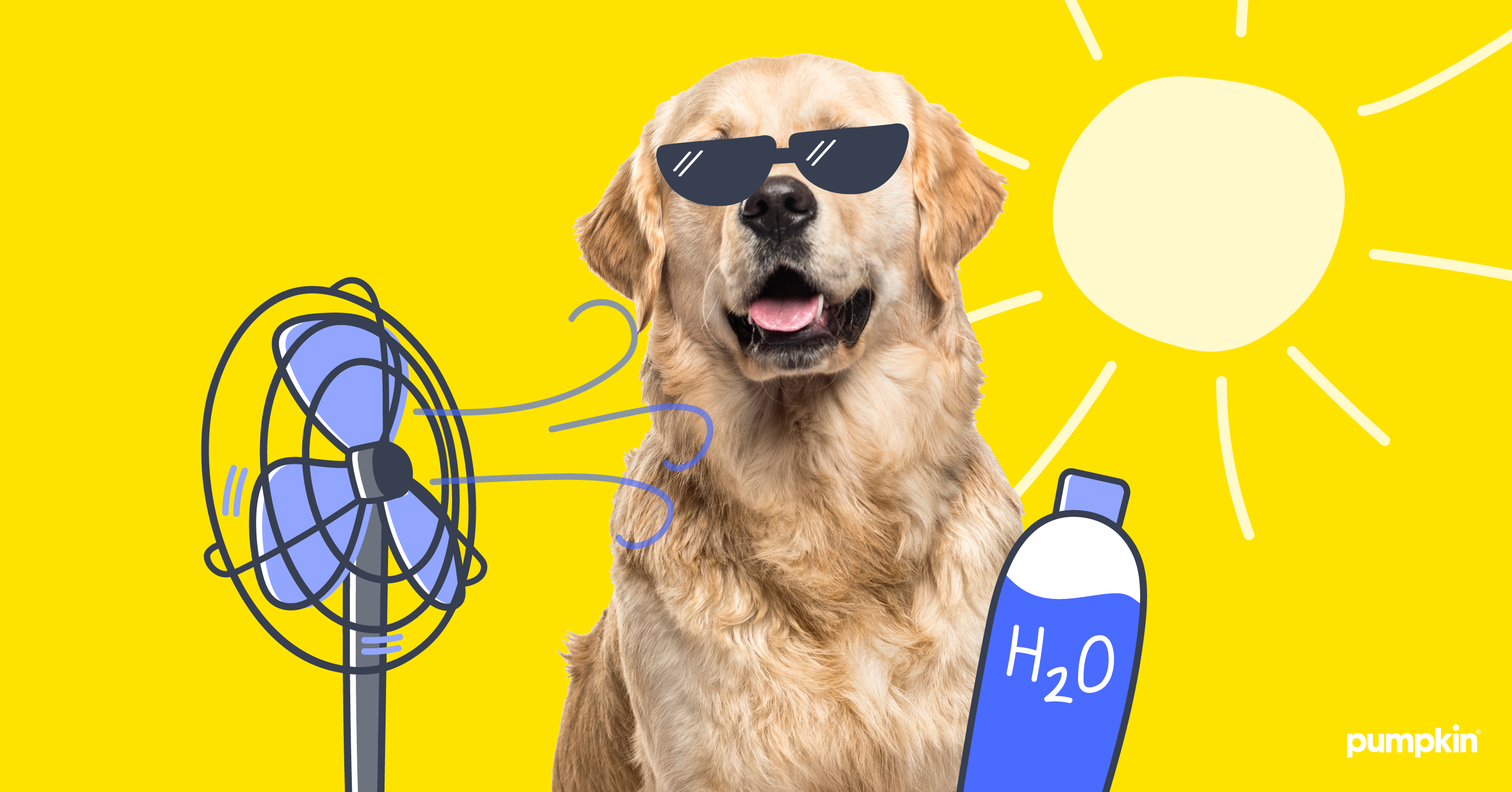The temperatures are rising which means summer is on its way. More outdoor activities are fun for us and our pets, but our furry friends can run into serious trouble without the right precautions. Learn how to keep your pets safe while having fun in the sun.
Summer pet safety at home
Even when you’re at home, hot summer days can pose special risks for your pet. Here are some tips to keep your dog or cat safe at home when the temperatures soar.
1. Keep up with vaccinations
Dogs and cats come into contact with more animals during the summer months when everyone is outdoors enjoying the weather. Up-to-date vaccinations can protect them from illness and disease carried by other animals.
2. Prevent fleas, ticks, and heartworm
Start the summer off right by ensuring your dog or cat has the proper protection against pesky insects and parasites. Pumpkin offers preventive care packages to help your dog or cat stay protected all summer long.
3. Get pet insurance
No matter how cautious you are, the truth is accidents and illnesses happen all the time. So before you embark on your summer adventures, it’s a good idea to enroll in a pet insurance plan to help you protect your pet and cover vet bills.
4. Beware of loud noises
From your neighbor starting up their lawnmower to fireworks on the 4th of July, loud noises often fill the summer air. If your pet runs for the hills over loud noises, talk to your vet about ways to calm your pet’s anxiety. Keeping them secure in the house away from noise and confusion is best.
5. Provide plenty of clean water and shade
Dehydration and heatstroke are real threats to your pet’s health in hot weather. Provide plenty of fresh water for your pet to drink both in the house and in the yard. A good rule of thumb is to provide one ounce of water for every pound of your pet’s weight.
Tip: Brachycephalic or flat-nosed pets like Pugs, Bulldogs, Persians, and Himalayans, along with puppies, kittens, and senior dogs and cats are especially susceptible to overheating.
6. Know the signs of dehydration and heatstroke
If your dog is getting overheated, move them to the shade or place them into cool, not cold water. Offer cool, not cold water to drink. You can also put a wet, cool towel over your pet to cool them off.
Signs of Dehydration
- Lethargy
- Panting or drooling
- Dry nose
- Dry, sticky gums
- Thick saliva
- Loss of skin elasticity
- Loss of appetite
- Vomiting with or without diarrhea
Signs of Heatstroke
- Excessive panting or drooling
- Bright red gums
- Increased heart rate
- Disorientation or very slow responses
- Body temperature over 104°
- Vomiting or diarrhea
- Seizures or collapse resulting in coma
7. Avoid fertilizers and pesticides
Fertilizers and pesticides may contain toxic chemicals that can poison your pet. Keep dogs and cats off chemically treated lawns for 24 hours after treatment. Several pet-friendly options are available during the summer when your pet is likely to be outside more often.
Garden plants can be toxic to your pets as well. Learn to recognize the poisonous plants to your dog and poisonous plants to your cat to reduce the risk of gastrointestinal upsets and poisoning. However, keep in mind that there’s a risk of vomiting and diarrhea when an animal ingests plant material. The ASPCA is a great resource for an extensive database of plant toxicity levels for pets.
8. Don’t shave your dog or cat’s fur!
You might think you’re doing your pet a service by shaving off an extra layer for those hot days, but your pet’s fur actually shields them from cold and heat. It can help protect them against sunburn as well.
9. Watch out for hot sidewalks
Take walks during the early morning hours when temperatures are at their lowest. Dogs tire faster in hot weather, so shorter walks may be necessary.
Sidewalks get hot fast on blazing summer days, and hot asphalt can burn your dog’s paw pads, causing extreme pain. If walking is a must, try summer booties designed to protect your dog’s paws from hot pavement.
Pet safety at the beach or pool
When you’re at the beach or pool, most of these are only applicable to dogs – but important to know, nonetheless!
10. Reduce time on wet and hot sand
Walking or running on hot sand can be tiring and increase risk of overheating as well as torn ligaments and tendons. Wet sand can also cause blisters on paw pads. Keep walks and runs short and carry water at all times. Booties made for hot pavement and sand work well, but the sun can still tire out your pooch.
11. Protect against sunburn
Dogs with white fur, thin short hair, or pink skin can get sunburn easily. Protect them with a shady area for resting, and put sunscreen on their ears, nose, and coat periodically during your time outdoors.
12. Check water conditions
Strong currents are dangerous for even the most accomplished swimmers of the canine world. Sea lice and jellyfish are easy targets for dogs running in the surf. Ask the lifeguard or ranger about water conditions to keep your dog safe and never let your dog run unaccompanied along the beach.
13. Rinse off seawater
Salts and minerals in seawater can damage your dog’s coat and also cause vomiting and sickness if your dog drinks too much of it. Monitor your dog’s activity around the salty seawater and rinse them off at the end of the day.
14. Put your pooch in a life vest
Even the strongest swimmer can tire out after a long time in the water, and dogs are no exception. Put a life vest on your dog when at the beach or a pool to keep them afloat. Dogs can’t tell you they’re tired until it’s too late!
Traveling safely with your pets
How lucky are we to have airlines and lodging facilities that allow us to bring our beloved furbabies on our trips? Most pets enjoy being included in family vacations, but here are some precautions you can take to keep them safe when traveling.
15. Never leave your pet unattended in the car
Cars heat up fast in hot weather. On an 80° day a car’s interior can rise to 114° in 30 minutes. Many states have “hot car” laws to protect unattended pets left alone in vehicles. A cracked window will not help either.
You can put a cooling mat inside a travel crate or bed during travel, but that won’t keep the car interior from heating or your pet safe from overheating. Never ever leave your pet in a parked car unattended – even for a few minutes.
16. Keep them secure with a carseat or seatbelt
Whichever mode of transport you use in your travels, keeping your pet safe during sudden stops and preventing escapes is crucial.
Unsecured dogs and cats can wander the vehicle and obstruct driving, or fall out of moving vehicles through wide-open windows. Crates are the most secure, but seatbelt accommodating tethers and harnesses, or a pet car seat that enables your smaller pet to see out windows while tethered are safe as well.
17. Secure them in the RV
RVs move around a lot during travel, which makes a secured travel crate or seat belt tether even more important. These can help keep your pet from wandering while the coach is moving and keep them safe if there are any sudden stops along the way.
Baby gates work very well to keep your pet inside the RV during rest stops and refueling. Make sure your pet has a microchip or tags on their collar in case of accidental escape.
Never leave your pet unattended in the RV for long periods of time. Most campgrounds forbid it, but even with an air conditioner on, there can be power outages or other problems that can spell trouble for a pet left inside. Be sure to crack the upper vents or a screened window to allow for proper ventilation while you are away for any reason.
At the end of the day, nothing beats enjoying the great outdoors with your fur family. No matter where this summer takes you, we hope our safety tips help keep you and your pet happy and healthy.




